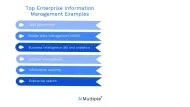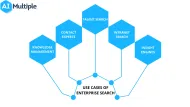Knowledge Management in 2024: 5 Benefits & 7 Challenges


For organizations searching for ways to look inwards for improvement, revamping knowledge management practices can be huge. We answered all your knowledge management related questions:
- What is knowledge management?
- What are the benefits of knowledge management?
- What are some prerequisites to its implementation?
- What are challenges to effective knowledge management?
- How can AI transform knowledge management?
What is Knowledge Management?
Knowledge management is the process where value is derived from knowledge by making it accessible to everyone within an organization. It is a multidisciplinary approach that aims to achieve objectives through the best possible use of knowledge.
Some general objectives associated with knowledge management include:
- Improved performance and innovation
- Communication of ‘lessons learned’
- Integration and continuous improvement
5 Primary Benefits of Knowledge Management
Knowledge management, when executed effectively, can ultimately lead to increased revenue, cost savings, and reduced risk. Some additional benefits associated with knowledge management are:
- Faster access to information and knowledge, allowing employees to be more efficient and productive
- A better decision making process by access to the right knowledge, in the right format, when it’s necessary.
- Improved innovation and collaboration; enabling the whole organization to access perspectives of different business units
- More streamlined business processes
- Increased customer satisfaction as a result of all of the above working together to create an ideal product and buying experience

Image source: Enterprise Knowledge
Prerequisites to Knowledge Management
When beginning any knowledge management implementation practice, there are some things that can be done to help ease the process. First, it is important to consider the ‘enablers of knowledge management’, which are:
- Culture: Support of the processes, ideals, and goals related to knowledge management throughout an entire organization to help obtain a competitive advantage.
- Measurement: Effective knowledge management systems have measurable effect on company performance. For example, by disseminating their sought after information, experts can receive fewer queries and focus better.
- Processes: Every business process needs to include steps for capturing relevant business information. Collaborate with those who work with the ‘knowledge’ to develop procedures for capturing said knowledge. By collaborating with these end users to develop the knowledge-capture process, organizations can achieve better results than with a generic knowledge management procedure
- Technology: Having the right tools can be extremely advantageous when it comes to day-to-day practical applications and uses
Understanding and considering these enablers from the beginning can help an organization to ensure they stay on track to effective knowledge management practices. Implementing a reward system may be helpful initially to encourage the rapid and correct adoption of knowledge management systems.
Knowledge management is not an overnight process, but rather is the result of an alignment across leadership, culture, communication, content, technology, and more. However, some of the greatest factors that can determine the success of knowledge management are executive approval and involvement and cultural acceptance of knowledge management practices.
7 Challenges of Knowledge Management
Though knowledge management can lead to a wide range of positive outcomes in an organization, it is not without its own challenges. Many of these are related to technology and the need for integrated systems and tools that can be created, accessed, and shared with the right people.
A few common, but manageable challenges associated with effective knowledge management within an organization include:
- Lack of executive support and leadership: As a result of short-termism prevalent in most public and private companies, knowledge management gets deprioritized
- Implicit knowledge held by key employees that leave with the information
- ‘Silos’ between locations or departments slow information dissemination
- No single version of truth in data, leading to inconsistencies
- ‘Captured’ knowledge that exists in non-integrated systems
- Weak ongoing efforts to maintain staff training and develop new knowledge management techniques over time
- Insufficient capture of process and legacy knowledge
However, these challenges can be easily overcome with efficient management and communication within an organization from the start.
Knowledge Discovery & Detection
One of the major prerequisites for knowledge management is that an organization understands what knowledge it has and where it is coming from. Subsequently, it may be necessary to perform an ‘audit’ that defines an organization’s existing knowledge sources, while also potentially discovering hidden knowledge that might be held within existing data. Remember that knowledge can reside both internally and externally, so it is important to consider both sides of the equation.
There are a few different types of knowledge that organizations often possess:
- Explicit knowledge: Articulated knowledge that is expressed and recorded as words, numbers, and other easily communicated formats. It is achieved via document management, intelligence gathering, data mining, and similar. Dependent on accurate articulation of needs, knowledge of the sharing process, and completeness of sources.
- Tacit knowledge: Held by humans, this includes understandings derived from emotions, experiences, insights, and intuitions. Gathered through knowledge surveys, questionnaires, interviews, focus groups, and similar. Culture is particularly important here.
- Embedded knowledge: Locked in processes, products, culture, and similar. Obtained via observation, analysis, reverse engineering, and modeling. It plays a major role in a number of these processes.
It is important also to organize and assess the knowledge that your organization has via mapping, categorizing, indexing, and evaluating assets.
Different types of data will have different methodologies for the most effective management, analysis, and sharing. For example, with embedded knowledge, it may be more helpful to run workflow analyses, whereas, with tacit knowledge, focus groups and knowledge coordinators may be more effective. Many of these tasks require systems that are capable of complex categorization and retrieval mechanisms. Currently, numerous vendors are offering easy-to-use solutions to categorize and retrieve internal data.
Knowledge Management & Artificial Intelligence
Knowledge management and AI are closely related fields because they are both deeply concerned with knowledge; the difference lies in how. AI gives machines the ability to learn and knowledge management allows for a better understanding of knowledge. These two things together mean that AI can take this knowledge and expand it beyond what is immediate and apparent.
The relationship between these two disciplines has opened the door for cognitive computing. This is where computerized models simulate human thought processes through deep learning artificial neural network software. In other words, AI facilitates the mechanisms for machines to accumulate knowledge and learn.
Ultimately, machines will contain knowledge obtained from different sources and systematic rules for processing such information. This will later empower them to be able to use knowledge and make better decisions.
For more on knowledge management
It is clear that the future of knowledge management only stands to become more integral over time as our businesses and lives become increasingly complex.
If you’re interested in learning more about AI, data, and how organizations are evolving to meet these needs, be sure to check out our blog.
And if you need a knowledge management solution, we have a data-driven list of vendors prepared.
We will help you choose the best tool based on your specific needs:
Featured image source: Groom Talent

Cem has been the principal analyst at AIMultiple since 2017. AIMultiple informs hundreds of thousands of businesses (as per similarWeb) including 60% of Fortune 500 every month.
Cem's work has been cited by leading global publications including Business Insider, Forbes, Washington Post, global firms like Deloitte, HPE, NGOs like World Economic Forum and supranational organizations like European Commission. You can see more reputable companies and media that referenced AIMultiple.
Throughout his career, Cem served as a tech consultant, tech buyer and tech entrepreneur. He advised businesses on their enterprise software, automation, cloud, AI / ML and other technology related decisions at McKinsey & Company and Altman Solon for more than a decade. He also published a McKinsey report on digitalization.
He led technology strategy and procurement of a telco while reporting to the CEO. He has also led commercial growth of deep tech company Hypatos that reached a 7 digit annual recurring revenue and a 9 digit valuation from 0 within 2 years. Cem's work in Hypatos was covered by leading technology publications like TechCrunch and Business Insider.
Cem regularly speaks at international technology conferences. He graduated from Bogazici University as a computer engineer and holds an MBA from Columbia Business School.
To stay up-to-date on B2B tech & accelerate your enterprise:
Follow on


Comments
Your email address will not be published. All fields are required.